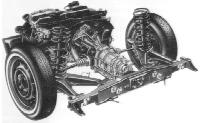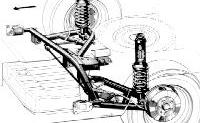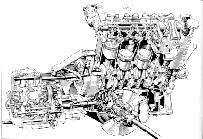The VW K 70
The K 70 was VW's first water-cooled, front-engine car and helped pave the way for the
later Audi 80 and VW Passat/Dasher.



 The VW K70 outside (1973) and inside (1970); artist's view (1970)
The VW K70 outside (1973) and inside (1970); artist's view (1970)
In 1969, VW bought NSU whose headquarters were in Neckarsulm, Germany, and
merged them with Audi. NSU was predominantly known for its motorcycles and
small rotary-engine powered cars. It's RO 80
was the first car designed for rotary power from the beginning,
featuring a twin rotor Wankel 115hp engine. At the same time, it
developed, but never actually produced the K 70, a conventional
water-cooled front-engined vehicle.
Facing a large investment in the K 70, and a reputation for unreliability of
the RO 80 (later fixed by Wolfsburg engineers, but too late to save the
model; production stopped in 1977 after only 37,204 RO 80), the company was
ripe for takeover. VW won the race, competing mainly with FIAT, whom VW
wanted to keep out of the German market.
Before production started in August 1970 VW decided it needed to modify the
K 70 before changing the NSU moniker on the front grill with its own and ended
up making significant, although mostly undetectable on the outside, changes
to the car. The main problem for VW engineers was that VW already produced
another car of the same size: the VW 411 (= Type 42). In the release notes
of the K 70 (= Type 48) VW stated that
"type 48 and type 42 are of similar size. Both cars have similar front and
rear suspensions as well as passenger-cells with effective protection by front
and rear crush sections."
So VW engineers had to improve the K 70 without impairing VW 411 sales.
To make the K 70 competitive it had to get an improved 411-like rear suspension
as well as improved crash safety and better brakes (The front disk brakes were
mounted inside the engine bay causing overheat problems). Some further improvements
haven't been ready when production of the K 70 started in a production plant
at Salzgitter (25 miles southwest of Wolfsburg): In 1971 VW made some interior
changes like the replacement of the K 70's steering wheel and seats with those
from the VW 411 as well as minor exterior changes like the use of Audi bumpers.

 The rear suspensions of VW 411 (left; including engine and gearbox) and
VW K 70 (right)
The rear suspensions of VW 411 (left; including engine and gearbox) and
VW K 70 (right)
VW initially offered a 1.6l SOHC engine with 75 HP (optionally 90 HP) for the
K 70 providing a top speed of 92 (99) mph. In contrast to all other VW models
the K 70 was only available with a manual 4-speed gearing; there was no version
with automatic transmission.
 Engine and gearbox of the VW K 70.
Engine and gearbox of the VW K 70.
Note that the front brakes are mounted inside the engine bay.
Faced with lower than expected sales, in May 1973 VW offered a 1.8l 100 HP
engine, providing a top speed of 101 mph. After further disappointing sales,
the car was dropped from the line in February 1975 with total sales of 211,127
units.
One of the reasons of this poor number of sales is that the VW K 70 always had to
compete against other VW's: Until July 1974 against VW 411/412, after August 1973
against VW Passat / Dasher.
Comparing some technical data shows that VW Passat and VW 411/412 were strong competitors
of the VW K 70 concerning performance and fuel consumption (1974 models):
| Model | Engine | Top Speed | Acceleration 0...100 km/h | Fuel consumption |
|---|
| VW K 70 LS | 1.8l/90hp | 162km/h (101mph) | 13 sec. | 13.5l/100km (17.5mpg) |
| VW 412 LS | 1.8l/85hp | 158km/h (99mph) | 14.5 sec | 12.5l/100km (19mpg) |
| VW Passat TS | 1.5l/85hp | 168km/h (105mph) | 12 sec | 10l/100km (23.5mpg) |
The car never officially made it the US.
Reynold Klomp informed me, he has a
K70 For Sale.
Jan-Anders Lindqvist has Another
K70 Page
And Claudius has a page of
K70 Links including
this page!
A reader sent in his K70 memories and thoughts:
It is mostly unknown that the competition between the first generation
of the Audi 100 and the K70 was most likely the major reason why VW
never really focussed on, even neglected the K70.
While that Audi was a typical car of the late 1960s, the K70 concept was
about 10 to 15 years advanced. Unfortunately it was never completely
mature (like the engine block which sometimes 'blew up' what resulted in
a sudden loss of all the engine oil - no damage, just a big mess).
Overall the slightly less expensive K70 still was the better car,
offering more space, higher safety standards and a number of convenience
features like a glove compartment of the size of a small trunk. The real
trunk had about 700 liters or 25 cuft.
Even serviceability was better than that of many today's cars, for
instance, the clutch could be replaced through a slot between engine and
transmission, none of both had to be taken out.
Submitted by Ulrich Link, Brampton, Ontario
Return to Factory Pictures
 Return to Wolfsburg Trip page
Return to Wolfsburg Trip page
 Return to Scot's page.
Return to Scot's page.
Last updated 16Jun99
 The VW K 70/Questions/Comments
The VW K 70/Questions/Comments
Additional information, research, and pictures provided by Ralf Ziegler.











 The VW K 70/Questions/Comments
The VW K 70/Questions/Comments